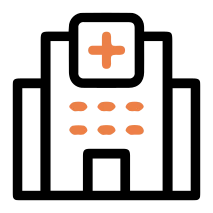Bronchiolitis in children is one of the most common lower respiratory tract infections seen in infants and young children, especially during the winter and early spring seasons. It primarily affects children under two years of age and is caused by viral infections that lead to inflammation and congestion in the small airways of the lungs called bronchioles.
For parents, hearing a baby wheeze or cough persistently can be terrifying. Thankfully, most cases of pediatric bronchiolitis are mild and resolve with supportive care. However, in some children—particularly premature babies or those with underlying health conditions—the illness can be more serious and require hospitalization.
This comprehensive guide explores the causes, symptoms, treatment, and prevention of bronchiolitis in children, using friendly and professional language. Keywords like “bronchiolitis in infants,” “viral lung infection in babies,” “childhood wheezing causes,” and “treatment of bronchiolitis” are integrated throughout to ensure this article reaches and educates as many caregivers as possible.
What is Bronchiolitis?
Bronchiolitis is an acute viral infection that affects the lower respiratory tract in young children. It is characterized by inflammation, swelling, and mucus buildup in the bronchioles—the smallest airways in the lungs. This condition leads to difficulty in breathing, wheezing, coughing, and sometimes reduced oxygen levels.
Most cases are caused by viruses, especially Respiratory Syncytial Virus (RSV), which spreads easily through respiratory droplets or contaminated surfaces. Although adults may experience RSV as a common cold, babies can develop severe bronchiolitis due to their smaller and more delicate airways.
Causes of Bronchiolitis in Children
Viral Triggers
The most common cause of bronchiolitis in children is RSV (Respiratory Syncytial Virus), responsible for over 70% of cases. However, other viruses can also cause bronchiolitis, including:
- Rhinovirus
- Adenovirus
- Influenza
- Parainfluenza virus
- Human Metapneumovirus
These viruses attack the lining of the bronchioles, triggering inflammation, increased mucus production, and narrowing of the airways.
Risk Factors
Certain children are more prone to developing severe bronchiolitis:
- Infants under 6 months of age
- Premature babies
- Babies with congenital heart or lung disease
- Infants with weakened immune systems
- Exposure to tobacco smoke
- Crowded living conditions or daycare attendance
Understanding these risk factors can help parents and healthcare providers take preventive steps and initiate timely care.
Symptoms of Bronchiolitis in Children
Recognizing the Signs
Symptoms of bronchiolitis in babies usually begin with signs of a common cold, such as a runny nose, mild cough, and low-grade fever. However, within a few days, the symptoms may progress to involve the lower respiratory tract, leading to:
- Wheezing or whistling sounds during breathing
- Rapid or labored breathing
- Nasal flaring
- Retractions (chest wall muscles pulling in)
- Persistent cough
- Feeding difficulties due to breathlessness
- Irritability or lethargy
- Bluish tint on lips or nails (cyanosis), in severe cases
These symptoms can peak between days 3 and 5 of illness. Most children recover within 1 to 2 weeks, but some may need hospital support if they struggle to breathe or feed.
Diagnosis of Bronchiolitis
Clinical Evaluation
Diagnosing bronchiolitis in children is primarily clinical and based on physical signs and history. A doctor may:
- Listen to the child’s chest for wheezing or crackling sounds
- Check for oxygen saturation levels
- Assess respiratory rate and effort
Usually, no lab tests are required unless symptoms are severe. In some cases, the doctor may order:
- Chest X-ray to rule out pneumonia
- Nasal swab tests to identify the virus
- Blood gas analysis in hospitalized children
Early diagnosis is crucial for managing symptoms effectively and preventing complications.
Treatment of Bronchiolitis in Children
Supportive Care at Home
Most cases of bronchiolitis in infants can be managed at home with supportive care. The goal is to keep the child comfortable and ensure adequate hydration and oxygenation. Key measures include:
- Frequent breastfeeding or formula feeding to prevent dehydration
- Saline nasal drops and nasal suctioning to relieve congestion
- Cool-mist humidifier to ease breathing
- Monitoring for signs of worsening breathing
Hospital-Based Treatment
Some children with severe symptoms or risk factors may require hospitalization for:
- Oxygen therapy to manage low oxygen levels
- IV fluids if they are unable to feed
- Nebulized hypertonic saline (used in select cases)
- Monitoring for apnea or respiratory failure
Antibiotics are not effective, as bronchiolitis is usually viral. However, they may be prescribed if a secondary bacterial infection is suspected.
Prevention of Bronchiolitis
What Parents Can Do
While it’s hard to avoid viruses completely, certain measures can significantly lower the risk of bronchiolitis in children:
- Frequent handwashing for caregivers and family members
- Avoiding contact with sick individuals
- Keeping babies away from crowded areas during peak season
- No smoking around the baby
- Regular cleaning of toys and surfaces
For high-risk infants, doctors may recommend palivizumab, a monoclonal antibody injection given monthly during RSV season to prevent severe infection.
Table: Mild vs Severe Bronchiolitis in Children
| Characteristic | Mild Bronchiolitis | Severe Bronchiolitis |
|---|---|---|
| Breathing | Mild wheezing, normal oxygen levels | Labored breathing, nasal flaring, low oxygen |
| Feeding | Feeds well | Unable to feed, requires IV fluids |
| General activity | Alert and playful | Lethargic or irritable |
| Hospitalization | Not required | Often needed |
| Risk of complications | Low | High, especially in premature or chronically ill babies |
Frequently Asked Questions (FAQs)
What is bronchiolitis and how is it different from bronchitis in children?
Bronchiolitis is an inflammation of the bronchioles, the smallest airways in the lungs, and typically affects infants and young children under two years. It is almost always caused by a viral infection, especially RSV. On the other hand, bronchitis refers to inflammation of the larger airways (bronchi) and is more common in older children and adults. While both can involve coughing and breathing difficulties, bronchiolitis usually comes with more wheezing and rapid breathing in babies. The treatment approach also differs—bronchiolitis is managed mainly with supportive care, while bronchitis may sometimes require medications like bronchodilators.
What are the first signs of bronchiolitis in babies?
Bronchiolitis often starts with mild symptoms like a runny nose, sneezing, and low-grade fever, similar to a common cold. Within a few days, the child may develop a persistent cough, wheezing, and difficulty breathing. Some babies may struggle to feed or become unusually sleepy or irritable. The symptoms typically worsen around the third to fifth day of illness. Parents should monitor closely for signs like rapid breathing, chest retractions, or bluish lips, which indicate a need for urgent medical care.
Is bronchiolitis in children contagious, and how does it spread?
Yes, bronchiolitis is contagious. It spreads through droplets released when an infected person coughs, sneezes, or talks. Children can also catch the virus by touching contaminated surfaces and then touching their face. RSV and other viruses causing bronchiolitis are highly infectious, especially in daycare settings or crowded environments. Practicing good hygiene, such as frequent handwashing and cleaning toys, can reduce the risk of transmission.
When should a child with bronchiolitis see a doctor or go to the hospital?
You should seek immediate medical attention if your child:
- Has rapid, labored, or noisy breathing
- Is feeding poorly or vomiting feeds
- Becomes unusually sleepy or unresponsive
- Has bluish skin, especially around the lips or fingers
Also, premature babies, children with heart or lung problems, or those under 3 months of age should always be evaluated early in the course of the illness. Even if symptoms seem mild at first, bronchiolitis can progress quickly in some children.
How is bronchiolitis treated and how long does recovery take?
Treatment for bronchiolitis focuses on supportive care. This includes keeping the child well-hydrated, clearing nasal passages, and monitoring breathing. Mild cases improve at home with proper care, while severe cases may require hospitalization for oxygen and fluids. Most children recover fully within 7–10 days, although the cough and wheezing may linger for up to 2–3 weeks. There is no specific antiviral treatment for RSV, but experimental treatments are being explored.
Can bronchiolitis cause long-term damage to a child’s lungs?
In most cases, bronchiolitis resolves completely without long-term consequences. However, some children—particularly those who had severe bronchiolitis or underlying conditions—may experience recurrent wheezing or asthma-like symptoms later in life. This doesn’t mean every child with bronchiolitis will develop asthma, but there is a noted correlation. Long-term follow-up may be needed in such cases to monitor lung health.
Can bronchiolitis be prevented with vaccines?
Currently, there is no widely available vaccine for RSV, the most common cause of bronchiolitis. However, researchers are working on vaccines, and some RSV immunizations are being studied for broader use. For high-risk infants, especially premature babies, monthly injections of palivizumab can help reduce the risk of severe RSV infections during peak seasons. General prevention includes minimizing exposure to sick individuals, regular handwashing, and avoiding smoke exposure.
Is it safe to use over-the-counter cold medications for babies with bronchiolitis?
No, over-the-counter cough and cold medications are not recommended for infants and young children with bronchiolitis. These medications can cause serious side effects and have not been proven to be effective. Treatment should focus on supportive care like hydration, nasal saline drops, and keeping the air moist. Always consult your pediatrician before giving any medication to your baby.
Are antibiotics used in the treatment of bronchiolitis?
Antibiotics are not effective against bronchiolitis because it is usually caused by viruses. They are only used if a secondary bacterial infection, such as pneumonia or ear infection, is suspected or confirmed. Giving antibiotics unnecessarily can lead to side effects and antibiotic resistance. Most children improve with rest, fluids, and supportive respiratory care.
Can a child get bronchiolitis more than once?
Yes, a child can get bronchiolitis multiple times, especially during the cold and flu seasons. While the first episode is usually the most severe, repeat infections may still cause symptoms. Each episode is typically triggered by a new viral infection. Strengthening the child’s immune system through good nutrition, adequate rest, and avoiding unnecessary exposure to sick contacts can help reduce the frequency and severity of future infections.
Research References on Bronchiolitis in Children
| Title of Study | Author Name |
|---|---|
| Respiratory Syncytial Virus and Bronchiolitis in Infants | Dr. Anita Sharma |
| Clinical Management of Pediatric Bronchiolitis | Dr. Rajeev Khurana |
| Role of Hypertonic Saline in Bronchiolitis Treatment | Dr. Shalini Mehra |
| Long-Term Outcomes after Severe Infant Bronchiolitis | Dr. Vikram Verma |
| Palivizumab Prophylaxis for High-Risk Infants | Dr. Sujata Reddy |
| Viral Etiology of Bronchiolitis in Hospitalized Children | Dr. Kunal Gupta |
| Differences in Mild vs Severe Bronchiolitis Outcomes | Dr. Ramesh Tiwari |
| Bronchiolitis and Risk of Childhood Asthma | Dr. Nisha Bajaj |
| RSV Vaccines: Current Progress and Future Directions | Dr. Arvind Rao |
| Parental Management Strategies for Children with Bronchiolitis | Dr. Devika Sen |






 and then
and then